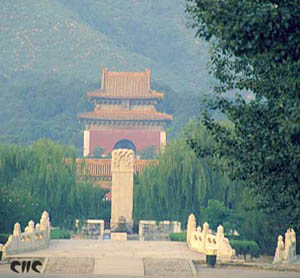Travel Agenda
- 8:30-From Westin hotel to the Badaling Great wall
- 10:00-visit Great wall
- 12:00-have dinner in Golden palace,then visit Jingtailan Craft Factory
- 14:00-visit Dingling Tomb
- 15:30-visit The Scred Way
- 18:00-Westin hotel
A. Dingling Tomb

Dingling lies 50KM north-west of Beijing ,which is the only one of the tombs that has been excavated, although 13 of the 16 Ming emperors are buried in this 40-sq-km area, often referred to as the Thirteen Tombs(Shisanling).The other tombs, such as Changling, which was started in 1409 and took 18years to complete is the tomb of Emperor Yong Le and, so the story goes, of 16 concubines who were buried alive with his corps. Dingling ,the tomb of Emperor Wanli, is the second largest tomb. Over six years the emperor used half a million workers and heap of silver to build his necropolis and then held a wild party inside the completed chambers. It was excavated between 1956 and 1958 .you can now visit the underground passageways and caverns. The underground construction covers 1195 sq meters, is built entirely of stone , and is sealed with an unusual lock stone. The tomb yielded up 26 lacquered trunks of funerary objects, some of which are displayed on site; others have been removed to Beijing museum and replaced with copies.
B.The Scred Way

The seven-KM ¡°spirit way¡± starts with a triumphal arch, then goes through the Red Gate, where officials had to dismount, and passes a giant tortoise(made in 1425) bearing the largest stele in China. This is followed by a guard of 12 sets of stone animals. Every second one is in a reclining position, legend has it, to allow for a¡±changling of guard¡¯ at midnight. Beyond the stone animals are 12 stone-faced human statues of generals, ministers and officals, each distinguishable by headgear. The avenue culminates at the Dragon and Phoenix Gate.
C.The Great wall at Badaling

Great wall, Known to the Chinese as the 10,000Li wall¡±(5000KM),the Great wall stretches from Shanhaiguan Pass in the Gobi Desert, crossing five provinces and two autonomous regions.
The undertaking was begun 2000years ago during the Qin Dynasty(221-207BC),when China was unified under Emperor Qin Shihuang, separate walls, constructed by independent kingdoms to keep out marauding nomads, were linked up. The effort required hundreds of thousands of workers, many of them political prisoners, and 1-years of hard labor under General Meng tian. An estimated 180 million cubic meters of rammed earth was used to form the core of the original wall,and legend has it that one of the building materials used was the bodies of deceased workers. The wall never really did perform its function as a defense line to keep invades out. As Genghis Khan supposedly said,¡± The strength of a wall depends on the courage of those who defend it¡±. However, it did work very well as a kind of elevated highway, transporting men and equipment across mountain terrain. Its beacon tower system, using smoke signals generated by burning wolves¡¯s dung, transmitted news of enemy movements quickly back to the capital. During
Ming dynasty (1368-1644) a determined effort was made to rehash the whole project, this tome facing it with bricks and stone slabs-some 60 million cubic meters of them. They created double-walling running in an elliptical shape to the west of Beijing, and did not necessarily follow the older earthern wall. This Ming project took over 100 years, and costs in human effort and resources were phenomenal.
Most travelers see the wall at Badaling,70km north-west of Beijing at an elevation 0f 1000meters.It was restored in 1057 with the addition of guard rails. The section is almost eight meters high with a base of 6.5 meters and width at the top of almost six meters. It runs for several hundred meters, after which, if you keep going, are unrestored sections where the crowds peter out. Originally the wall here could hold five horsemen riding abreast-nowadays it ¡®s about 15 tourists walking abreast.